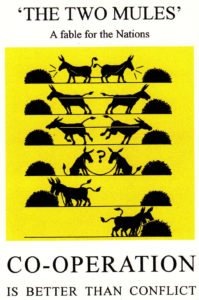| Exercise, handout number | Time | Method | material |
| Opening session | 10 min | Exchange in a circle – what has happened since our last meeting regarding conflicts? | |
| The orange conflict: different options to solve a conflict | 15 min | Raising questions about options in order to solve the conflict | Orange, flipchart, copy |
| Optional: donkeys | 10 min | Raising questions about options in order to solve the conflict | picture |
| Role play: 2 strategies to solve a conflict | 20 min | Groups of 3, 2 rounds role play, plenary | Scenario of a simple conflict. Instruction: role play 1: students quarrel, teacher decides Role play 2: students quarrel, will be sent to a mediator |
| Principles of a peer mediation | 20 min | Plenary | Copy |
| Attributes of the mediator | 15 min | Group discussion – what is needed for good listening? Brainstorming | Copy |
| Skills of a student mediator | 15 min | exercise | Copy |
| Good and bad listening – mini role play | 15 min | exercise | Facilitators/teachers will demonstrate good/bad listening in a mini role play |
| Evaluation | 10 min |
Handout 7: The orange conflict
 |
Duration:
10 minutes |
 |
Aim:
This exercise aims at pointing out the advantages of a process which tries to understand the motivation of parties in a conflict. Normally we are thinking in categories of win-lose, either-or or come up with a typical compromise. But sometimes there is a solution beyond these possibilities: a win-win solution. |
 |
Materials:
Flipchart No. 1, (flipchart samples see additional material) |
 |
Instruction for implementation:
The facilitators describe a conflict between siblings: “Two sisters are having a conflict over an orange. Unfortunately, there is only one orange left and the shops are closed. Their mother hears their shouting, opens the door and asks her daughters what is going on. Both girls insist on wanting the whole fruit.” What can be done? The facilitators invite the participants to brainstorm different solutions and note them on a flipchart. Possibly options 1 – 4 will be mentioned, the facilitators add option 5 in order to exemplify a win – win solution. Option 1: The mother cuts the orange in half (typical compromise). Option 2: The mother gives the orange to girl A (win – lose). Option 3: The mother gives the orange to girl B (win-lose). Option 4: Neither girl gets the fruit. (lose-lose). Option 5: The mother asks why her daughters want the orange and finds out that girl A wants to eat the fruit, girl B wants to bake a cake and needs the skin. (win-win) Alternative: use the example of a pumpkin (flesh inside to make a soup, skin to carve a Halloween face). Evaluation procedure: The facilitators ask the participants why option 5 is different than the other possibilities. What has the mother done instead of coming up with a spontaneous reaction? They point out the advantage of looking behind a position in order to identify the needs of the parties. |
Handout 7B: The orange conflict

Handout 8: Principles of the mediation process
There are four decisive principles of the mediation process:
- Voluntariness
The parties participate on a voluntary basis. A forced participation can hinder the process of opening up. Students and mediators have the right to stop the process. - Confidentiality
What is said during the mediation is treated confidentially by all partners involved (students and mediators). However, the mediators can ask the students whether they can discuss the case on the basis of anonymity with mentoring teachers. - Individual responsibility
The parties discuss and develop their own solution. Mediators’ don´t dictate a solution. - Impartiality
Mediators are impartial. They don´t take sides and assure that both parties have an equal opportunity to express himself/herself. If a mediator cannot guarantee his/her neutrality anymore (e.g. because he/she is a friend of a party), he/she should ask a colleague to take over.
Role of mediators
As mediators, you offer your help and assistance to other students to moderate a talk between two conflicting parties.
The mediators are responsible for the process of the meeting but not for the outcome.
The mediators underline that it is the task of the parties to find a solution and that they are the “experts” of their problem.
Mediators are not judges and don´t take sides. They are impartial through the whole process.
Principles of nonviolent conflict resolution
Conflicts are normal
Conflicts arise wherever people come together. We cannot avoid conflicts – but we can treat our conflict partners with respect and solve our conflicts without violence.
Different truths
People experience the same conflict very differently – everyone has their own version of the truth. It is important to accept the other person’s truth.
Solving conflicts cooperatively
No one is to blame for the conflict. We have a common problem and we will look for a common solution. In order to find the solution, we need to take a step back from the positions of the individuals to discover the underlying feelings, needs, and interests.
Solving conflicts creatively
The best solution is not always a compromise. Sometimes it is possible to resolve a conflict in such a way that both or all conflict parties are satisfied.
Handout 9: Attributes of a peer mediation in schools
- The mediation is conducted by peers
- Mediators are impartial
- Voluntariness
- Conflict parties are present
- Parties agree to communication rules
- Mutual empathy is encouraged
- Respectful dialogue
- Watch the inner dialogue: how did each party contribute to the escalation of the conflict?
- Mediators don´t blame the parties
- No one-sided solutions
- A written contract
 |
Source:
|
Handout 10: Skills of a mediator
 |
Duration:
15 minutes |
 |
Aim:
By answering the questionnaire the participants think about skills a mediator should have in order to build up trust and reliability. It is a low threshold activity, easy to conduct. |
 |
Materials:
copies |
 |
Instruction for implementation:
Copies of the questionnaire are passed around, the trainers ask the participants to mark the skills a peer mediator should have with a cross, then turn to his/her neighbor and compare the results. After the exchange in pairs, the facilitators start a wrap up in the plenary, asking for controversial assessments and discussing them. It is helpful to also have a look at the handout “principles of a mediation process”. Questionnaire: Peer mediators should…
Evaluation procedure: The participants will be asked to judge how familiar they feel with the mindset of a mediator: e.g. impartiality, non-judgmental, equal treatment of both parties. The activity is one step to lay down the attitude of a mediator. |
 |
Source:
|